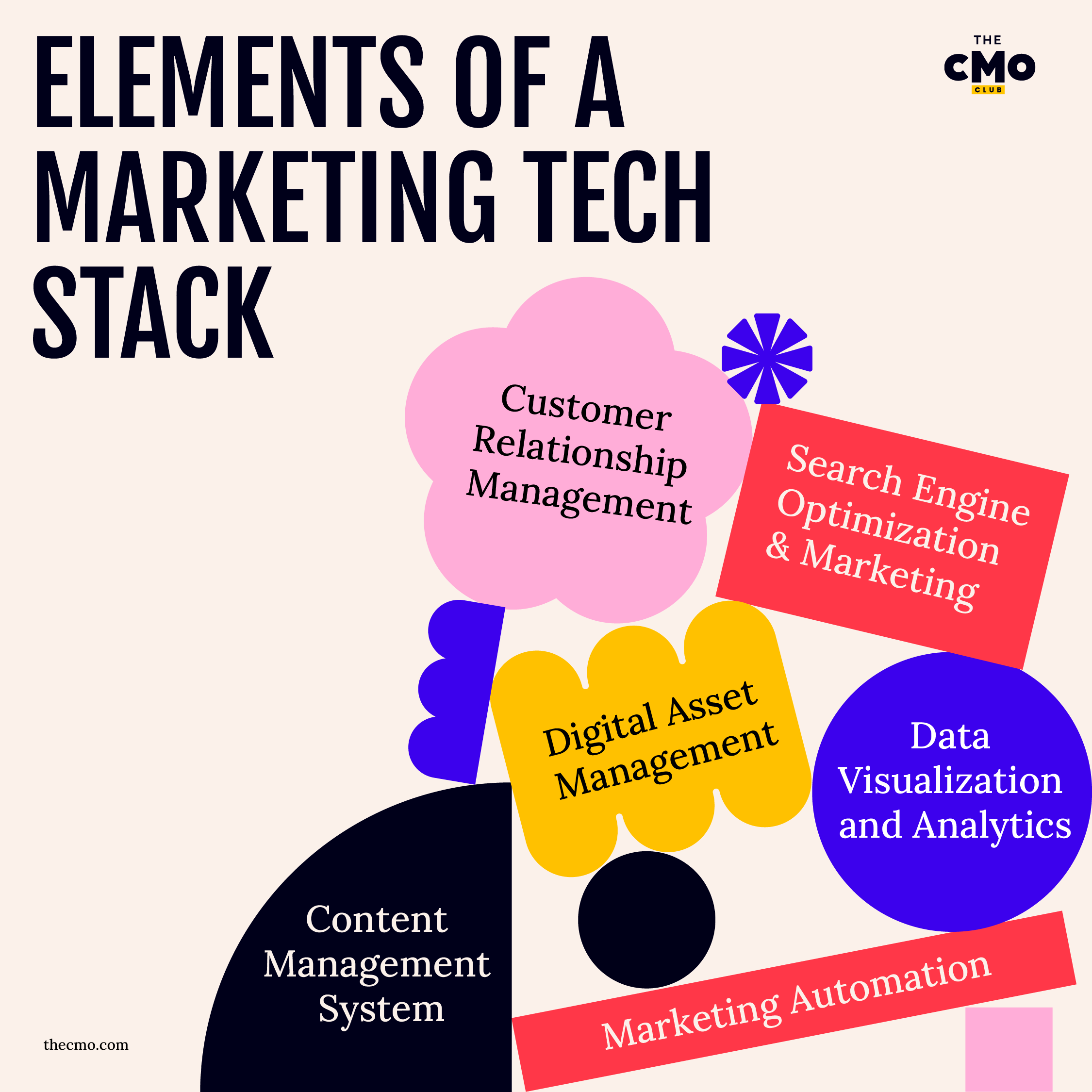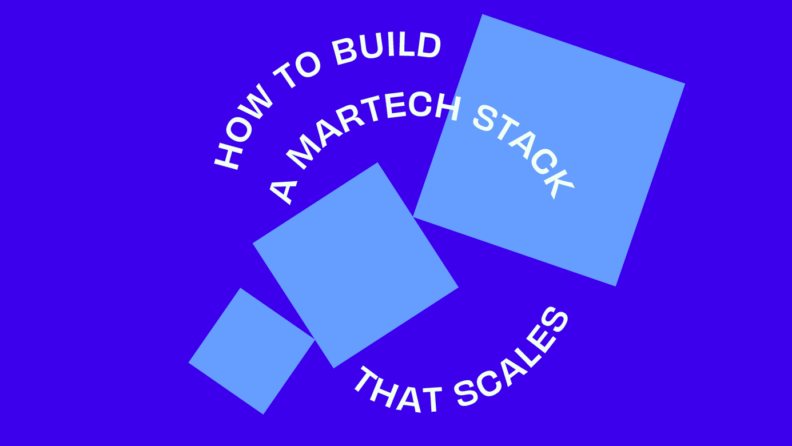As business sectors are shifting to a digital-first focus, technology and SaaS organizations experiencing rapid growth must implement a MarTech stack that supports their expansion at scale. MarTech (or marketing technology) has exploded with innovation and diversity to meet this shift. Today, marketing leaders have access to tools that can automate business intelligence reporting, lead generation, content syndication, audience communication, and more.
But with these apps and technologies comes increasing complexity to an organization’s MarTech stack. The lack of interoperability of software can cause more headaches than prevent them, especially when the average organization leverages 185 different apps in their tech Stack. With a quarter of an organization’s tech stack belonging to marketing, many variables are left up to APIs or Zapier and spare dev-support to ensure a successful MarTech stack.
So how do you build a MarTech stack that scales with your organization? With over a decade of experience in digital marketing and having attended a number of informative MarTech conferences, I’ve seen what successful (and weak) MarTech stacks look like and how to build them. So let me share with you what is a MarTech stack, the essential elements to include, and how to build a MarTech stack that scales with your organization.
What is a MarTech Stack?
A marketing technology stack or MarTech stack is a collection of technologies and software (such as HubSpot, Salesforce, Hootsuite, and Mailchimp) used to plan, execute, and manage an organization’s marketing operations. You can build a MarTech stack with a handful of platforms or integrate dozens of applications into a system.
Example MarTech stacks commonly include tools that:
- Streamline workflow and marketing processes through automation
- Increase transparency of data through marketing attribution
- Improve how you acquire and retain customers.
No two MarTech solutions are alike. I have found that many MarTech stacks are built on a combination of platforms the entire organization uses, software that serves a niche use case, and bespoke solutions designed internally.
Elements of a Marketing Tech Stack
Though all MarTech stacks are unique, they tend to follow a particular formula of elements. So what marketing platform, technology or software is essential for your MarTech stack?
There are six core elements I have seen that every MarTech stack should include. Some can be serviced through a singular platform while others require an ecosystem to fulfill.

Marketing Automation
If you need to help your sales team nurture new leads, your social media team manage posts and messaging, and your customer service team improve the user experience through dynamic chatbots, marketing automation software can help you serve more customers at scale.
The most effective marketing automation platforms combine social media marketing, email marketing, lead acquisition, and advertising into a single space. These all-in-one MarTech platforms typically come with one caveat though—a higher price tag.
Conversely, you can utilize more affordable options that focus on a singular function of the above. However, the more marketing tools you need to service any of the above, the more complexity you introduce.
Search Engine Optimization & Marketing (SEO, SEM)
It’s essential to have tools that support how your customers find you and how you get in front of them ahead of the competition. For this reason, common tools such as Google Ads and Microsoft Power BI are essential to growth.
With regard to Google’s constantly evolving algorithm updates, MarTech stacks must include software that supports:
- The ability to monitor your domain health and content search performance
- Functionality to quickly optimize landing pages and content
- Access to analytics for search performance
- Resources for paid search advertising
- The ability to monitor your domain and content search performance
- Functionality to quickly optimize content
- Access to analytics for search performance
- Resources for paid search advertising
- Abilities to perform a/b testing
Each of these functions is essential for you to consider in an SEO and SEM solution so that you can scale your organization’s growth and adapt to changing algorithm updates.
Data Visualization and Analytics
Marketers are involved in every stage of the sales and customer life cycle. Because of that cross-functional support, it’s paramount to access and attribute performance metrics and customer data to marketing actions to visualize that data and share it with the broader organization.
Without data visualization and marketing analytics tools like Google and Adobe Analytics, you’ll quickly feel like you’re fumbling around in the dark, trying to understand why your brand is under or overperforming.
Content Management System (CMS)
Managing all of your content marketing in an efficient and easy-to-use system (for example, Wordpress, or a custom solution) can enable your team to create and distribute content at any volume.
Whether you’re just starting or looking for a mature solution, your CMS can significantly advance or hinder your content production and distribution. At the bare minimum, you need a CMS solution with customizable storage options and multi-media support that integrates with your data analytics.
Digital Asset Management (DAM)
Storing all of your media types requires a single space that’s secure and easy to access for your organization.
A DAM system (for example, Brandfolder or Adobe Experience Manager) helps you store and manage media such as documents, images, graphics, and video. That storage is especially useful for content you don’t want publicly facing, such as sales decks, contractor files, staging content, marketing strategies, etc.
Customer Relationship Management (CRM)
Your customer relationships are the final pin and you must have software and technology that ensures a cohesive experience from marketing, to sales, to customer success.
The best marketing CRM software integrates with data analytics and automation to create the foundation for a strong MarTech stack.
How to Build a MarTech Stack that Scales
Every marketing leader must adapt their MarTech stack to the evolving needs of their target audience and the customer journey. With the elements above in mind, let me walk you through the steps to build a MarTech stack that scales with your organization’s growth.
1. Evaluate your current and future marketing needs
Before you start buying subscriptions, take a moment to assess your current and future needs. Does your organization require digital marketing features, such as search engine marketing and email marketing tools, or physical marketing, such as billboard ads?
As you consider what you need for your marketing campaigns, prioritize your list based on what solutions will enable scalable growth. Consider ease-of-use, the ability to expand seats or storage ad hoc, or features that would be nice to haves now but need to haves later.
2. Audit your current MarTech stack
Do you have an up-to-date list of marketing technology and software your organization uses? If not, I recommend taking the time necessary to review what you have for the following:
- What are the tools you use often or hardly touch?
- What is the cost for using those tools, factoring subscriptions, seats, and add-ons
- Are there limitations or unutilized functionality?
- Are there several niche tools that you can replace with a singular tool?
According to research by Gartner, marketers utilize just 42% of their MarTech stack capabilities. This step enables you to reduce waste in your marketing budget by analyzing what you truly need, which platforms have those features, and where features (and dollars) might overlap.
It can also be beneficial to chat with other leaders in your organization and understand what their needs are for a tech stack. Depending on the software, MarTech solutions can also service other business needs, multiplying the value potential of a software solution.
3. List your requirements
You’ll want to draft and maintain a list of requirements to implement and run the system as you build a MarTech stack that meets your organization’s needs.
- What is the onboarding process for new software?
- What are the system requirements for a new software?
- Are there security concerns that you need to address?
- What compliance requirements do you need to meet?
Any of these details can influence your MarTech stack implementation, so make sure to work with stakeholders and address them early on in the process. It’s also best practice to maintain and update this list as requirements change over time, making this process easier for you in the future.
4. Plan your MarTech stack rollout
Ensure all stakeholders are going to be available over the period the rollout will take place. Work with managers ahead of time so they’re comfortable with the new software and changes and can train their direct reports.
Create a roadmap with timelines for meeting the requirements listed above, going through the sales process and negotiating pricing for solutions, and working with stakeholders' availability. Consider whether you’ll receive onboarding and implementation support from the MarTech stack providers. Larger software vendors typically provide some level of assistance because your success with new MarTech means continued business for the vendor.
5. Implement
The time has come to build your Martech stack and implement it with your organization. The most important thing to consider is that during implementation, there are no shortcuts, no easy routes, and no cheap options. You cannot cut corners when you build a MarTech stack, or the problems you face now will only continue.
You must arrange your MarTech stack in a format that makes sense for your marketing team as well as the wider organization. It must work intuitively and facilitate an improved customer experience, streamlining or removing manual processes so your team and work more efficiently.
MarTech Tools to Include in Your Stack
Building a MarTech stack can feel like a daunting task when it comes to selecting the right solutions that fit your needs. I know exactly how carrying that weight feels and want you to know, you don’t have to do it alone.
I’ve taken the time to review the 10 Best Marketing Software to give you a head start. The solutions on this list were chosen based on my own criteria for software that can fit a variety of MarTech stacks and help you to improve your marketing efforts.. If you need to, seek guidance from your peers or experienced MarTech stack advisors.
Need Expert Help Selecting the Right MarTech Software?
I’ve partnered with the software comparison platform Crozdesk to assist you in finding the right software. Crozdesk’s MarTech Stack Advisors can create a customized shortlist of software solutions with unbiased recommendations to help you identify the solutions that best suit your business's needs. Through our partnership you get free access to their bespoke software selection advice, removing both time and hassle from the research process.
If you enjoyed this article, be sure to connect with me on LinkedIn, leave a comment below, or subscribe to The CMO newsletter for more great marketing content straight to your inbox.
You Might Also Like: 15 Emerging MarTech Startups To Watch In 2025


